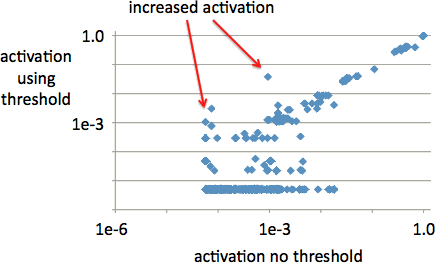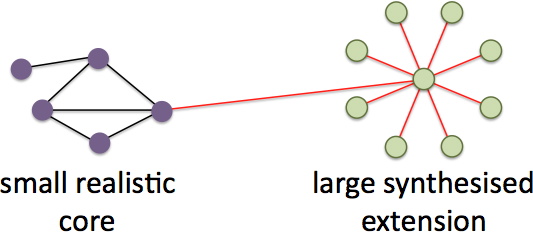Abstract
Various forms of spreading activation has been used in a number of web systems, not least in the PageRank algorithm. In our own work we have been using this as a technique for managing context over small and large ontologies, and both our own work and that in LarKC suggests that spreading activation has the potential to aid in reasoning over web-scale data sets including the growing set of linked open data resources. Of particular importance is that spreading activation can be applied locally to a dynamic self-selecting working set of an (practically) unbound linked data collection, as well as globally to the entire collection. However, this potential does not come without problems, some concerning the nature of the algorithm on any large data set, and some more to do with the particular nature of linked open data.
Keywords: spreading activation, reasoning, linked open data, context
References
-
Anderson, J. 1983. A Spreading activation theory of memory, Journal of Verbal Learning and Verbal Behaviour. 22, 261–295.
-
Bizer, C., Heath, T. and Berners-Lee, T. 2009. Linked Data — The Story So Far. International. Journal on Semantic Web and Information Systems, 2009.
-
Crestani, F. 1997. Retrieving documents by constrained spreading activation on automatically constructed hypertexts, in Proc. of EU- FIT 97- Fifth International Congress on Intelligent Techniques and Soft Computing, pp. 1210–1214.
-
Crick, F. and Mitchison, G. 1983. The function of dream sleep, Nature, 304, 111–114.
-
Dix, A. 2006. The brain and the web – intelligent interactions from the desktop to the world. keynote at IHC 2006, Natal Brazil. http://www.hcibook.com/alan/papers/brazil2006/
-
Dix, A., Katifori, A., Lepouras, G., Vassilakis, C. and Shabir, 2010. Spreading Activation Over Ontology-Based Resources: From Personal Context To Web Scale Reasoning. Int. Jnl of Semantic Computing,. 4(1) pp.59-102.
-
Dix, A. 2011. Context and Action in Search Interfaces, New Trends In Search Computing, LNCS. 6585, 39–49.
-
Dodds, L. 2009. Understanding the Big BBC Graph, 11th June 2009. http://blogs.talis.com/n2/archives/569
-
Fensel, D. and van Harmelen, F. 2007. Unifying reasoning and search to web scale, IEEE Internet Comp 11, 2, 94–96
-
Hasan, M. 2003. A spreading activation framework for ontology-enhanced adaptive information access within organisations, in Proc. of the Spring Symposium on Agent Mediated Knowledge Management (AMKM 2003).
-
Hopfield, J. Feinstein, D. and Palmer, R. 'Unlearning' has a stabilizing effect in collective memories, Nature, 304, 158–159.
-
Katifori, A., Vassilakis, C. and Dix, A. 2008. Using spreading activation through ontologies to support personal information management, in Proc. of Common Sense Knowledge and Goal-Oriented Interfaces, (at IUI 2008).
-
Katifori, A., Vassilakis, C. and Dix, A. 2010. Ontologies and the Brain: Using Spreading Activation through Ontologies to Support Personal Interaction. Cognitive Systems Research, 11 (2010) 25–41.
-
LarKC (2011). The Large Knowledge Collider, accessed 25/2/2011. http://www.larkc.eu/
-
Liu, W., Weichselbraun, A., Scharl, A. and Chang, E. 2005. Semi-automatic ontology extension using spreading activation, Jal of Universal Know. Mngmnt, 0, 1, 50–58.
-
Page, L., Brin, S., Motwani, R. and Winograd, T. 1998. The pagerank citation ranking: Bringing order to the web. Tech. Report, Stanford Digital Library Technologies Project.
-
Qasem, A., Dimitrov, D. and Heflin, J. 2007. Effecient selection and integration of data sources for answering semantic web queries, in Proc. of the First Int. Workshop “New Forms of Reasoning for the Semantic Web: Scalable, Tolerant and Dynamic,” Co-Loc. with ISWC 2007 and ASWC 2007, Vol. 291. http://CEUR-WS.org/Vol-291
|

poster
[PDF 325K]
![]()

Fig1. Different shapes of the transformation function f.
[zoom image]

(i) transform non-linear near zero [zoom image]

(ii) transform linear near zero [zoom image]
Fig. 2. Greedy node collection

Fig. 3. Unexpected increase in activation
[zoom image]

(i) star [zoom image]

(ii) wheel [zoom image]
Fig. 4. Simulated graphs